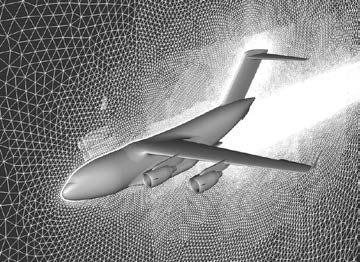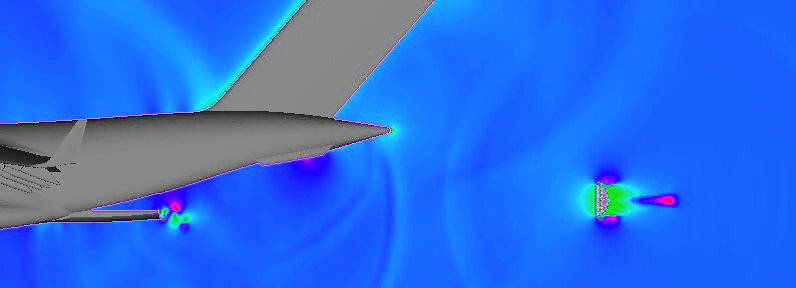A current area of interest in the US Army operational and test community is the application of aerial delivery at high speed and at relatively low altitudes. The High-Speed Container Delivery System (HSCDS) is such a program intended to address this type of operational need. In conjunction with this program, a series of simulations have been conducted that attempted to cover a parameter space of operational variables such as aircraft type, aircraft flight speed, extraction line length, and drogue parachute design and size. The objective here is that with validated and verified modeling and simulation results anchored to actual flight test data, future exploratory test and development work may be performed with increased reliance on information derived from modeling and simulation with potential savings in the use of airdrop assets.
The use of Cobalt in this application is to explore the utility of numerical simulations of full aircraft in flight for the purpose of predicting operational conditions expected to be encountered during flight tests of new cargo extraction methods for aerial delivery applications.
The C-130 and C-17 aircraft were modeled with cargo doors opened. Specific attention was paid to the grid in the area aft of the aircraft since the parachute grid was placed there.
The simulation data was processed by requesting the calculation of the forces to be determined for the drag parachute part of the simulation model . A Matlab script was also used to process the simulation force data to determine maximum and mean values of the time record for the force values in the drag direction. Dimensions of the drogue parachute geometry were based upon those for the parachutes used in the Flight Tests. Air speeds for each simulation run were maintained at a constant for each simulation.
In general, the numerical simulation data showed satisfactory agreement to the experimental flight test data but there is great room for improvement in both methodologies in order to tighten up the agreement between the two. The level of agreement is believed sufficient to have confidence in the use of the computational techniques to provide predictive tools for future system development efforts, hopefully providing some relief from the need to perform as many flight tests in the future, although such tests will always be required for the refinement of such systems.
The full scope of the work can be found in the following paper: Optimizing Extraction Parachute Operational Parameters AIAA-2015-2102
The numerical simulations were performed at the U.S. Army Research Laboratory Department of Defense (DOD) Supercomputing Resource Center (ARL DSRC) and the U.S. Air Force Research Laboratory DOD Supercomputing Resource Center (AFRL DSRC) on computational hardware using software licenses for Cobalt supplied by the DoD High Performance Computing Modernization Program (HPCMP). Computational results were processed utilizing Utility Server (US) hardware at both Centers and were visualized using the EnSight software program.




